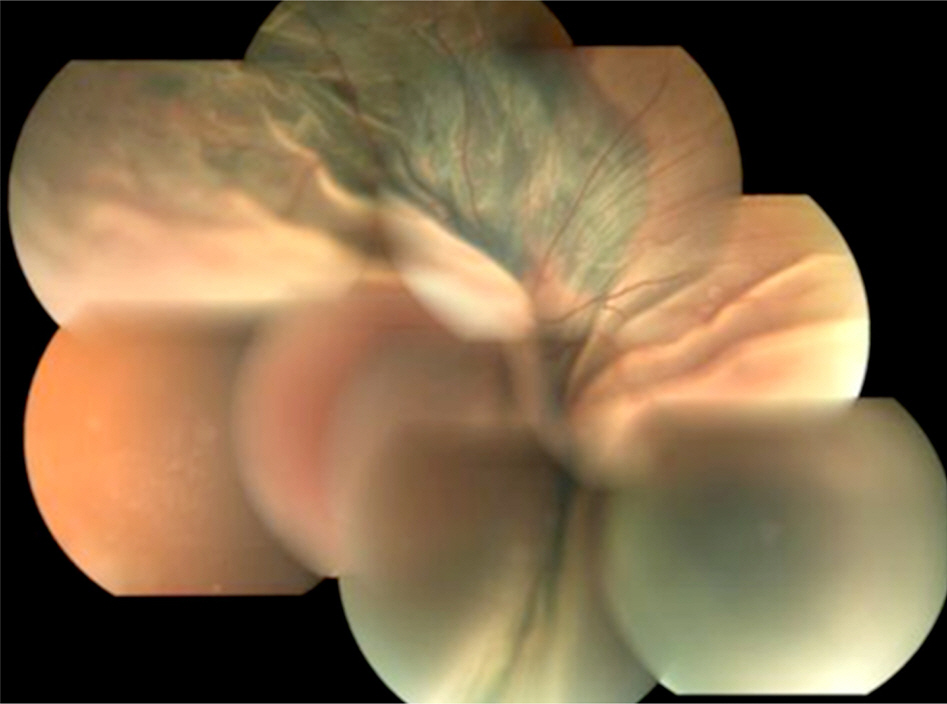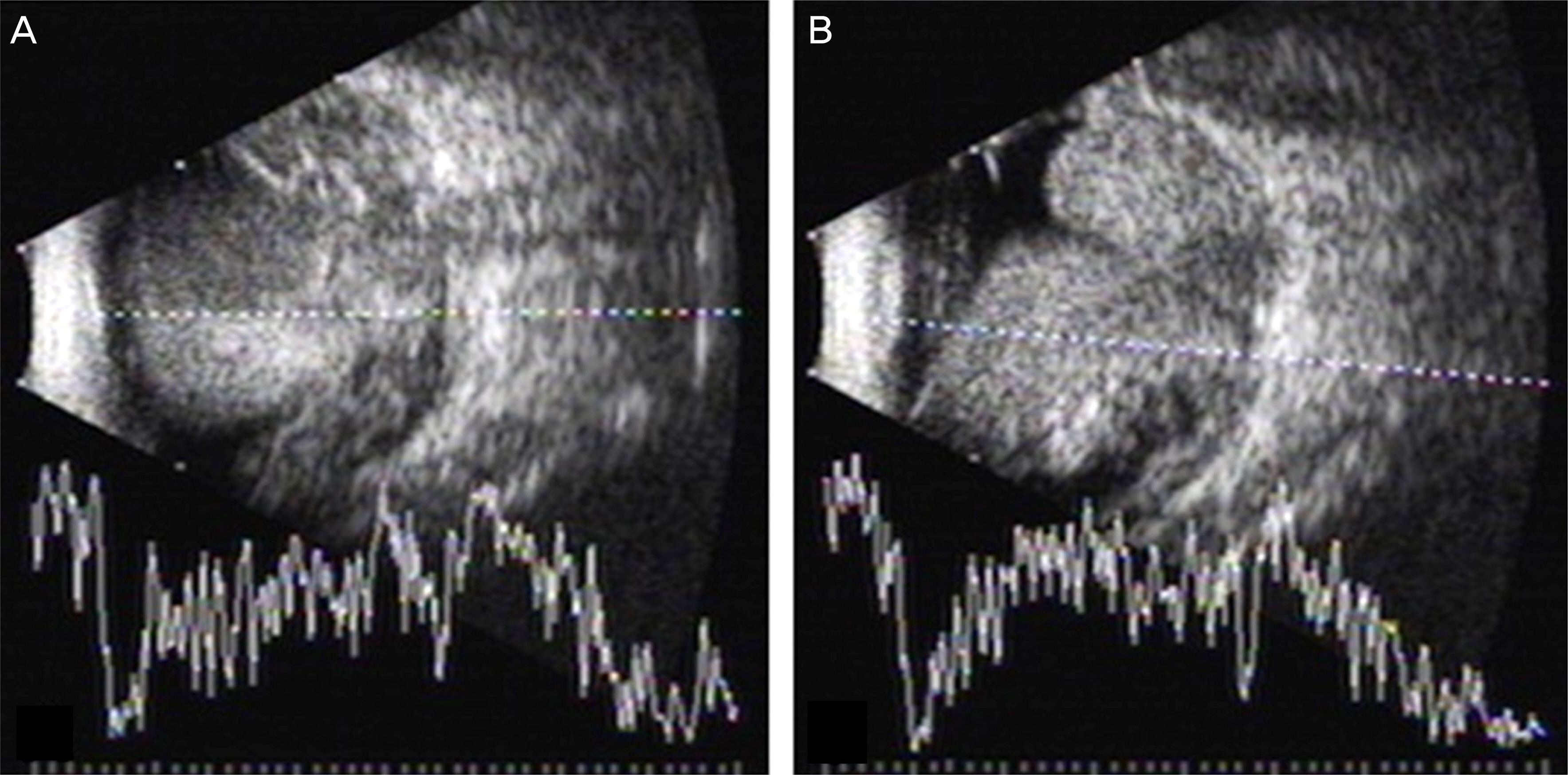J Korean Ophthalmol Soc.
2015 Feb;56(2):296-299. 10.3341/jkos.2015.56.2.296.
Massive Spontaneous Suprachoroidal Hemorrhage in a Patient with Heavy Alcohol Consumption
- Affiliations
-
- 1Department of Ophthalmology, Yonsei University College of Medicine, Seoul, Korea.
- 2Department of Ophthalmology, National Health Insurance Service Ilsan Hospital, Goyang, Korea. eunjee95@hanmail.net
- KMID: 2216017
- DOI: http://doi.org/10.3341/jkos.2015.56.2.296
Abstract
- PURPOSE
To report a case of massive spontaneous suprachoroidal hemorrhage in a middle-aged female with heavy alcohol consumption.
CASE SUMMARY
A 48-year-old female with a history of heavy alcohol consumption developed a massive spontaneous suprachoroidal hemorrhage in the right eye. Fundus examination and B-scan ultrasonography of the right eye revealed a hemorrhagic choroidal detachment with kissing choroidal sign. On systemic evaluation, she was diagnosed with alcohol-induced hepatitis, diabetes, and diabetic nephropathy. We performed trans-scleral drainage of the suprachoroidal hemorrhage, trans pars plana vitrectomy and silicone oil injection in her right eye.
CONCLUSIONS
To our knowledge, this is the first case report of massive spontaneous suprachoroidal hemorrhage in a patient with heavy alcohol intake.
MeSH Terms
Figure
Reference
-
References
1. WOLTER JR. Expulsive hemorrhage during retinal detachment surgery. A case with survival of the eye after Verhoeff sclerotomy. Am J Ophthalmol. 1961; 51:264–6.2. Chen YY, Chen YY, Sheu SJ. Spontaneous suprachoroidal hemor-rhage associated with age-related macular degeneration and anti-coagulation therapy. J Chin Med Assoc. 2009; 72:385–7.
Article3. Barsam A, Heatley CJ, Herbert L. Spontaneous suprachoroidal hemorrhage secondary to thrombolysis for the treatment of myocardial infarction. Clin Experiment Ophthalmol. 2006; 34:177–9.4. Winslow RL, Stevenson W 3rd, Yanoff M. Spontaneous expulsive choroidal hemorrhage. Arch Ophthalmol. 1974; 92:33–6.
Article5. Pe'er J, Weiner A, Vidaurri L. Clinicopathologic report of sponta-neous expulsive hemorrhage. Ann Ophthalmol. 1987; 19:139–41.6. MANSCHOT WA. Telangiectatic granulomas in an eye with spontaneous expulsive hemorrhage. Am J Ophthalmol. 1957; 43:872–9.
Article7. Ophir A, Pikkel J, Groisman G. Spontaneous expulsive supra-choroidal hemorrhage. Cornea. 2001; 20:893–6.
Article8. Chu TG, Green RL. Suprachoroidal hemorrhage. Surv Ophthalmol. 1999; 43:471–86.
Article9. Yang SS, Fu AD, McDonald HR. . Massive spontaneous choroidal hemorrhage. Retina. 2003; 23:139–44.
Article10. De Marco R, Aurilia P, Mele A. Massive spontaneous choroidal hemorrhage in a patient with chronic renal failure and coronary artery disease treated with Plavix. Eur J Ophthalmol. 2009; 19:883–6.
Article11. Hammam T, Madhavan C. Spontaneous suprachoroidal haemor-rhage following a valsalva manoeuvre. Eye (Lond). 2003; 17:261–2.
Article12. Kim M, Lee SC, Lee SJ. Abrupt spontaneous suprachoroidal hemorrhage post-23-gauge vitrectomy during peritoneal dialysis. Clin Ophthalmol. 2013; 7:1175–9.
Article13. Srikanth K, Kumar MA. Spontaneous expulsive suprachoroidal hemorrhage caused by decompensated liver disease. Indian J Ophthalmol. 2013; 61:78–9.
Article14. Chak M, Williamson TH. Spontaneous suprachoroidal haemorrhage associated with high myopia and aspirin. Eye (Lond). 2003; 17:525–7.
Article15. Peng GS, Yin SJ, Cheng CA. . Increased risk of cerebral hemorrhage in Chinese male heavy drinkers with mild liver disorder. Cerebrovasc Dis. 2007; 23:309–14.
Article16. Kaufman DW, Kelly JP, Wiholm BE. . The risk of acute major upper gastrointestinal bleeding among users of aspirin and ibuprofen at various levels of alcohol consumption. Am J Gastroenterol. 1999; 94:3189–96.
Article17. Patra J, Taylor B, Irving H. . Alcohol consumption and the risk of morbidity and mortality for different stroke types--a systematic review and meta-analysis. BMC Public Health. 2010; 10:258.
Article18. Salem RO, Laposata M. Effects of alcohol on hemostasis. Am J Clin Pathol. 2005; 123(Suppl):S96–105.
Article19. Wakabayashi I, Marumo M. Ethanol inhibits store-operated Ca2+ entry of platelets. Pharmacol Toxicol. 2002; 90:226–8.20. McKenzie ME, Bell CR, Horowitz ED. . Effects of in vitro exposure of alcohol on surface receptor expression of human platelets. Clin Physiol Funct Imaging. 2002; 22:153–6.21. Mukamal KJ, Jadhav PP, D'Agostino RB. . Alcohol consumption and hemostatic factors: analysis of the Framingham Offspring cohort. Circulation. 2001; 104:1367–73.
Article22. Gorinstein S, Zemser M, Lichman I. . Moderate beer consumption and the blood coagulation in patients with coronary artery disease. J Intern Med. 1997; 241:47–51.
Article23. Ridker PM, Vaughan DE, Stampfer MJ. . Association of moderate alcohol consumption and plasma concentration of endoge-nous tissue-type plasminogen activator. JAMA. 1994; 272:929–33.
Article24. Meade TW, Chakrabarti R, Haines AP. . Characteristics affecting fibrinolytic activity and plasma fibrinogen concentrations. Br Med J. 1979; 1:153–6.
Article
- Full Text Links
- Actions
-
Cited
- CITED
-
- Close
- Share
- Similar articles
-
- A Case of Resolved Massive Suprachoroidal Hemorrhage after Sclerotomy in Penetrating Keratoplasty Patient
- A Case of Acute Angle-closure Glaucoma Secondary to Spontaneous Suprachoroidal Hemorrhage
- Spontaneous Rupture of the Internal Thoracic Artery Causing a Mediastinal Hematoma in a Patient with Alcoholic Liver Cirrhosis: A Case Report
- Spontaneous Arterial Bleeding in Patients with Alcoholic Liver Cirrhosis: a Series of Three Cases
- Spontaneous Suprachoroidal Hemorrhage Associated with Wet Type of Age-Related Macular Degeneration and Hypertension: Two Cases



